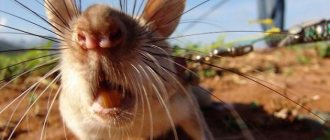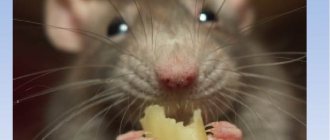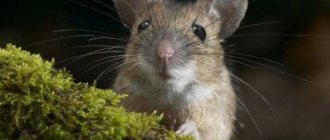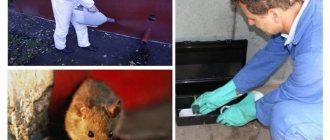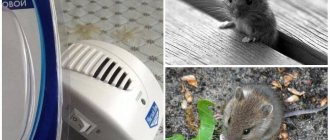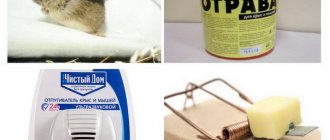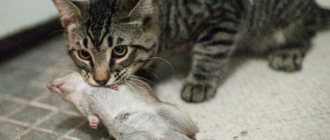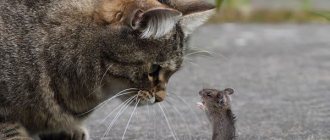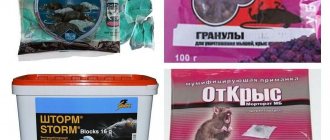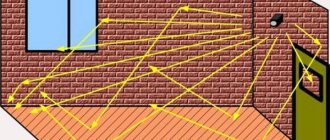Mice are a cosmopolitan mammal species
Mice have a wider distribution throughout the world than any other mammal except humans. Their geographic distribution has been aided by commensal relationships with humans that go back at least 8,000 years .
As commensal animals, house mice live in close proximity to humans and rely on us for food and shelter. They are at home in our homes, barns, outbuildings, warehouses, stores, granaries, fields and farms. But wild individuals are found in almost all habitats - from coastal meadows and dunes to the subalpine zone ( except for the highlands ). Mice also live on a number of sub-Antarctic islands; they are absent only in the Far North and Antarctica.
Photo: Wikipedia
Mouse - field rodent
A mouse is a funny little animal. It belongs to rodents. Lives in all countries of the world. Often mice settle closer to humans. Mice are divided into several types: house, field, forest and the smallest mouse.
All mice run fast and can jump. The mouse's main weapon is its sharp teeth. Mice are very active and voracious. They eat various plant grains, seeds, nuts, small insects, leaves, roots and stems of plants, and berries. Many house mice eat the same things as you and I - cheese, bread, meat, sweets.
The enemies are predators - cats, snakes, birds. The animals are actively breeding. They spend a lot of time in the hole, caring for their offspring. They also stock up on food for the winter in their burrows.
The mouse is a typical omnivore
Seeds and grains are the staple foods of house mice, although they are opportunistic omnivores that eat a wide variety of foods. Wild individuals feed on fleshy roots, leaves, stems, berries, insects, caterpillars, spiders, cockroaches, and invertebrate larvae. They do not disdain carrion . Commensal mice feed on any food available to humans, as well as paste, glue, soap and other household items. They especially love foods high in fat, protein and even sugar.
Most of the mice's water needs are met by the moisture in their food. Because they have the ability to concentrate urine, this allows them to colonize semi-desert areas . Mice fed seeds with up to 12% protein can survive without supplemental drinking, but above this protein level they require 3-13 grams of water per day.
Mice have a very high metabolism , so they need to eat 15 to 20 times a day. Because of this frequent need for food, most wild mice make their homes near a food source.
Poems about mice for children
Poems about mice are funny and funny; they will introduce kids to this funny animal. Read together poems about mice for children and learn something new about an old friend)))
* * *
The mouse to her friend hurried for tea: - I’ll arrive at twelve sharp. Meet me! I'll go with a black mole by car, I'll be there for lunch without being late. The baby mouse put on a shirtfront, checkered pants, like a monkey's; A raincoat with a clasp, earrings on the ears, a bracelet on the paw. Scarf and hat. The little mouse tried very hard: It took seven and a half hours to get ready. Night outside has come imperceptibly. Mouse to her friend For tea - late.
E. Frantsuzova
* * *
The mouse said to the mouse: “How much I love books!” I can't read them, but I can eat them.
Samuel Marshak
* * *
One day the mice came out to see what time it was. One two three four. The mice pulled the weights. Suddenly there was a terrible ringing sound - the mice ran away.
Samuel Marshak
* * *
The cat said to the mice: “Guys, let’s play hide and seek with you. Physical education does not harm, it increases appetite!” “Cunning cat,” the mice decided, “We’re not that stupid, let one play hide and seek, let’s run away, guys!”
Logacheva Tamara
* * *
The mouse put it in the pantry for the cats in the cat trap. And it was not without reason that they got caught, Three cats are in the cat-catchers - Now the thieves will know how to get into the pantry to get a mouse! “This is chalk, and this is a midge, There is a trap with bread crumbs...” Teaches the little ones from a book Under the bed is a mother mouse. “Don’t squeak loudly, children, Danger awaits on the buffet: Even though the white cat is dozing, It might bite you on the tummy!”
Lesnaya Yu.
* * *
The mouse found a piece of cheese. The mouse decided to eat it. It has gnawed so many holes in it that it itself is as round as cheese.
* * *
Little mouse in checkered pants Everyone was terribly tired - Every now and then the mouse ate. I ate everything. From morning till night! Well, at night I ate a lot. After all, with a rumbling stomach, you sleep wrong, and your dreams are wrong. That's why in the mink All the crusts have been eaten, The leg of the sideboard The frame of the portrait, That's why the mouse's pants are cracked Checkered, new, With a burgundy button... There are rumors that by summer the Mouse will go on a diet, But for now, for this year, They're digging in the mink new entrance.
T. Efimova
* * *
A mouse grumbled in the pantry: “Why is there a lid on the jar? What's under the lid? How to find out? Don't smell it, don't get it! There is, without a doubt, very tasty jam in this jar! Or my favorite jam! How can I eat it now?! Apparently “someone” forgets that this is just a storage room! Treat for friends! It’s not an exhibition, it’s a museum!”
S. Son
* * *
The mouse was in a hurry to visit, On the path she refreshed herself - She quickly ate a pound of selected millet, Forty pieces of bread crusts, Cheese crumbs Eight bowls And pistachios A couple of cups... She would have eaten a dozen, But she was in a hurry for dinner!
A. Vasiloi
* * *
The mice stole the cheese, threw a feast in the hole, sat down at the tables, ate their fill, lay down in their beds and fell asleep sweetly. They dream that there is a big Cheese Moon hanging over the hole!
N. Volkova
* * *
Two mice at the hillock Digged a small hole And four pantries To store grain. So they worked - they tried, They were almost left without paws: Very hard ground On a hillock near a stump. It's a pity that people didn't come up with shovels for mice.
A. Alferova
One mouse produces up to 10 litters per year
Under ideal conditions, one pair of mice and their offspring can produce more than 1,000 pups in a year . Breeding begins at 6-10 weeks of age, and each female can produce 5-10 litters per year. The estrus cycle is 4-6 days, with estrus lasting less than one day. After a short gestation period of about 3 weeks, 3 to 12 pups are born and the cycle begins again 12 to 18 hours after birth.
Photo: Nick Fewings
Newborn mice weigh about 1 gram , are naked except for short whiskers, and their eyes and ears are closed. They are fully covered with fur after 10 days, and by 14 days their eyes and ears are fully open and their incisors have erupted. The young are weaned and begin to leave the nest at the age of 20-23 days, weighing about 6 grams.
While favorable conditions (e.g. nutrition) determine reproduction in commensal populations, wild populations are seasonal breeders and their reproduction is likely influenced by a combination of day length and food availability. Mortality rates before independence were typically 60-70%.
Photo: Phys.org
Yellow-necked mouse - Apodemus flavicollis
Yellow-necked mouse
This is a fairly large mouse, the body length reaches 10-13.5 cm. The color of the fur is brown and red, a strip of yellow fur is visible around the neck, and a thin black line runs along the back. The ears are clearly visible and round in shape. The tail is bald, long, exceeds the length of the body, sometimes reaching 13 cm. This is a forest mouse, it lives in the forest and mountain forest zones of Western Europe. They inhabit nests and hollows, and can also dig holes. The mouse hole is lined with dry twigs, leaves and moss. To spend the winter they settle in human houses, and in the spring they return back to freedom. The yellow-throated mouse feeds on large seeds of deciduous trees. Prefers such food species as: acorns, maple seeds, linden, beech nuts. The wood mouse makes large reserves of food for the winter, which can sometimes reach 4 kg. They keep them in their homes. This red mouse is an excellent tree climber; it can climb trees up to 4 meters above the ground. She can also jump up to 1 meter in length. And if you compare the body size and the length of the jump, then the yellow-throated mouse is ahead of even the gray kangaroo. The female gives birth to 5-6 litters per year, with 6 cubs in each.
Mice live in small colonies or family groups
Depending on the prevailing environmental conditions, mice occur alone, in pairs, in small family groups, or in multiple families coexisting at very high densities. Social groups usually consist of a dominant male and several females.
Mice densities range from 10 individuals per square meter in commensal species to 1 individual per 100 square meters in wild species. Under ideal conditions, populations can grow strongly, with numbers exceeding 200,000 individuals per hectare .
Japanese (red, large forest) mouse - Apodemus speciosus
Japanese wood mouse
The Japanese mouse has a body of 10 - 12 cm, a red, brick-red hue, which is why it is often called the red mouse. The eyes are black and large. The ears are round and clearly visible. The tail reaches body length (up to 12 cm), the tip of the tail is usually white. The wood mouse lives in the subtropical regions of Japan and is also found in the Russian Federation. The great wood mouse eats a wide variety of cultivated cereals, herbs, bamboo, seeds of coniferous and broad-leaved species. The wood mouse settles on the edges of forests, constructing burrows there. Reproduction occurs in late spring and early autumn. A female mouse produces 6-7 cubs in each litter.
Mice are crepuscular animals
Mice are sensitive to bright light, so they are usually nocturnal or crepuscular. Commensal mice adapt to the daily routine of humans. Rodents alternate between sleep and wakefulness for 0.5-1.5 hours. The mouse's activity range is usually limited to an area with an average radius of 3 meters.
Using its superior senses of hearing, smell, taste and touch, the mouse becomes an expert in its range, learning and remembering the location of food, paths and obstacles. When a new object comes into their range, mice are usually not afraid to explore it.
Where do they live and what do they eat?
You can meet this gray animal in almost every corner of our planet. They live in deciduous and coniferous forests, in the tropics, in steppes and deserts, in wetlands and on mountain slopes. These rodents also live in human homes.
These small gray animals are capable of digging underground labyrinths for housing, can take over abandoned holes or make nests from grass and small twigs. Forest, steppe and mountain varieties of these small rodents swim very poorly, while their counterparts who live in swamps can make short swims.
These animals mainly eat food of plant origin:
- barley;
- oats;
- wheat;
- buckwheat;
- millet;
- fruits and seeds of bushes and trees.
Mice living in wet flood meadows and wetlands feed on the buds, leaves and flowers of shrubs and other plants. Some varieties are very fond of spiders, worms, beetles and other insects; such food is rich in proteins. Once in a human home, these rodents gobble up bread, sausage, potatoes, cheese and eggs with great pleasure.
Mice are used in nearly 75% of animal research procedures
The following are approximate figures for the use of model organisms in laboratory research:
- rats, mice and other rodents, universal laboratory species – 83.3%;
- fish, amphibians, reptiles and birds – 15%;
- sheep, cows, pigs and other large mammals – 1.5%;
- dogs and cats bred for research; the use of stray pets is unacceptable – 0.1%;
- Primates, mainly monkeys and macaques – 0.1%.
Photo: Genetic Engineering and Biotechnology News
Chimpanzees, orangutans and gorillas have not been used in most EU countries for more than 20 years, and in the UK their use is completely banned. Around this time, it was allowed to clone mice . The first cloned mouse, named Cumulina, was born on October 3, 1997 and lived for 2 years and 7 months.
Sandstone or gerbils - Gerbillinae
Gerbil mouse
The body of the gerbil is from 5 to 20 cm, brownish-gray. The tail is longer than the body, pubescent, with long hairs at the end that form a brush. The eyes are bulging and large. The ears are clearly visible. The gerbil mouse lives in deserts, semi-deserts of Asia and Africa. They dig holes where the whole large family of mice settles. Gerbils are diurnal. They feed mainly on various seeds and ground parts of plants. A female gerbil gives birth to up to 13 litters a year, with 4-7 babies in each. Life expectancy is 3-4 years. These mice do not hibernate in winter, but they can go into torpor.
80% of human genes have a comparable gene in mice
The mouse is an excellent model for studying human diseases because its DNA organization and gene expression are similar to those of humans: 80% of human genes have a comparable gene in mice. These rodents have a reproductive and nervous system similar to humans, and they suffer from many human diseases such as cancer, diabetes and even depression. Research in mice has helped us understand both human physiology and the causes and treatments of disease.
Without mice, organ transplantation, IVF, the creation of most vaccines and drugs, and understanding the immune system would be difficult.
Spiny (needle-shaped) mouse - Acomys cahirinus
Spiny mouse
This is a mouse with a long nose. The body length is 7-12 cm. The tail of the mouse reaches 13 cm. The color of spiny mice is white, reddish, and brown. The ears are round and clearly visible. The spiny mouse has large, bulging eyes. The spiny mouse has spines on its back like a hedgehog. And the lower part of the body is white. Quill mice are capable of regeneration. In case of danger, they can shed their skin, which quickly renews itself. The spiny mouse lives in Africa, on the islands of Crete, Cyprus and Saudi Arabia. The spiny mouse settles in burrows, which it digs itself or occupies the burrows of other rodents. The mouse hole is paved in the middle with grass and dry leaves. This is a nocturnal mouse, active at night and early in the morning. The spiny mouse lives in colonies.
Mice are talented athletes
Photo: HomeServe
Mice can jump almost 50 centimeters in height from a standstill and jump from a height of 4 meters without injury. But jumping is not all they are capable of. They are also excellent climbers and swimmers. But the cool thing about them is that they can squeeze through holes the size of a coin. And they are not bad sprinters; they can accelerate to 13 km/h !
The rat is the symbol of 2022
Each year, according to the eastern calendar, is named after one of the 12 animals. This tradition comes from China. The coming year of the rat 2022 will be the year of the white metal rat, and 2019 will be the year of the pig.
Chinese mythology gives wisdom to the rat. The Rat is very smart and cunning, it knows this very well and knows how to use it, it has excellent memory, which often helps in solving complex problems. He is well versed in art and patronizes it. He chooses his friends carefully. This is what next year's patroness will be like. In the new year, she will help those who have pure bright thoughts, a kind heart and a clear mind. Good deeds, behavior, integrity, aspiration and selfless actions are encouraged.
It will be great to make a New Year's symbol with your parents with your own hands for the New Year. The rat can be made of paper, fabric, or indeed any of your favorite materials.
Did you know?
- In the wild, mice rarely live longer than 18 months. In captivity, they live on average 2 years, only some laboratory specimens live up to 5 years.
- More than 30 species of mice are known. The most famous species is the common house mouse (Mus musculus).
- Research on mice has been awarded 30 Nobel Prizes.
- Mice are farsighted and colorblind . But at the same time they have excellent hearing with an upper sensitivity threshold of 100 kHz. For comparison, a person perceives sounds with a frequency of up to 20 kHz.
- Whiskers help rodents sense their environment and even detect temperature changes.
- The mouse uses its tail to balance itself when moving along very narrow wires and ropes.
- They cause significant damage by destroying crops and consuming and/or contaminating food intended for human consumption. They have also been implicated in the extinction of native species in the ecosystems they invaded and colonized.
- Mice do not sweat and cannot vomit. This is one of the reasons why the poison is so effective in killing these creatures.
- The length of a mouse's tail accounts for over 60% of their total body length.
- An adult mouse has a heart rate of 632 beats per minute (plus or minus 51 beats per minute). The human heart beats only 60 to 100 beats per minute.
- Mice groom themselves several times a day and are less likely than dogs or cats to carry parasites and viruses.
- In the city of Myshkin (Yaroslavl region), the world's only Mouse Museum , all exhibits of which are dedicated to mice.
- Male mice perform ultrasonic serenades for females, which is why they have been added to the short list of singing mammals that only includes bats, whales and humans!
- People have eaten mice since prehistoric times and are still served as a delicacy in eastern Zambia and northern Malawi, where they are a seasonal source of protein. They are also hunted by cats, wild dogs, mongooses, lizards, foxes, birds of prey and snakes.
- The mouse is a shamanic symbol of wisdom, mindfulness, discovery and organization.
Riddles about mice for children
Treat yourself and your kids with exciting riddles about rats and mice. Will the company guess the rodent? We offer you children's riddles about a mouse:
Lives in a mink. He chews the crust. Gray baby - Who is this?.. (Mouse)
Lives in a hole, gnaws on crusts. Short legs. Afraid of cats. (Mouse)
Collects grains in a hole. Runs away from evil cats. Everyone is scared of the baby, This little one... (Mouse) (A. Makarova)
He looks out of the crack, he’s afraid to get out. (Mouse)
Katya squealed something. The baby is surprised: “Why did you tremble, Katya?” After all, sitting in the corner... (Mouse)
In a hole, in a small house, Hiding from a cat... (Mice)
Underground, in a closet. She lives in a hole. Gray baby. Who is this?.. (Mouse)
I dug a hole - and in the hole lives Beady Eyes, baby. Gray-gray chews a ripe grain in a mink... (Mouse) (A. Izmailov)
Came out of the hole for a crust of bread. Bargained with a white cat, Paid with a gray fur coat. (Mouse)
Who hides crusts of bread in a deep hole, Gray with a little tail? (Mouse) (S. Azar)
Who scratches under the floor in the silence of midnight?.. (Mouse)
What kind of gray animal, with a long tail like a lace, just saw a cat and immediately ran into a hole? (Mouse)
Who rustles behind the wall, squeaks in a thin voice, You can’t hide the cheese from them. A thief to all thieves... (Mouse)
Who is rustling behind our closet? At night he scares Masha. The silly girl is hiding in the corner. Little gray one... (Mouse) (Ernst)
She's afraid of the cat. There's a hole in the floor, hiding there. Hiding for a break... Who does the cat catch? ...(Mouse) (G. Stupnikov)
Sharp teeth, Gray fur coats, Quick legs Running away from the cat. (Mice) (A. Alferova)
Pi, pi, pi - she said and immediately ran into the hole. What kind of baby is this? This is a little... (Mouse)
Features and habitat
The mouse is a mammal animal, the order of rodents and the suborder of mice. Rats, by the way, are very similar to mice and belong to the same suborder. The rodent order is one of the most numerous. There is no place on earth that these small animals have not conquered. They can handle any natural area; they are not afraid of either arid areas or snowy places.
They adapt to new living conditions so quickly that they cannot be frightened by any discomfort. Most often, rodents live in burrows, but they find food for themselves on the surface of the earth. Mice, for example, lead only a terrestrial lifestyle, although they have their own burrows.
The photo shows a mouse hole in the grass
The body size of an ordinary mouse is small - its length does not exceed 10 cm, and its weight is only 30 g; its muzzle is small, but its ears and eyes are large. This is understandable - mice constantly need to listen and look closely to see if there is any danger. The tail is not the most beautiful part of this animal’s body.
The fur on it is very sparse, and the length reaches half the length of the body. Moreover, if you look closely, you can see ring-shaped scales. But the mouse itself is not too worried about its beauty, because its entire body is adapted to survive in any conditions, and this is much more important.
The skeleton is strong, reliable and elastic, the color is gray with various shades, that is, exactly the one that will hide the animal from a quick glance, the movements are fast, nimble, dexterous, each part of the body is clearly honed by time for its specific functions and copes with them perfectly , otherwise the animal would not have survived to this day since the Paleocene.
A very interesting feature of the body of this rodent is the structure of the dental system. Mice have molars and two large pairs of incisors, which do not have roots, and because of this they constantly grow by 1 mm per day. So that such teeth do not grow to terrible sizes and simply fit in the mouth, mice are forced to constantly grind them down.
Mice have very interesting vision. It is well developed, because they need to see danger at a far distance. But white mice , that is, those that live as pets, have much weaker vision for the simple reason that they do not need to hide from danger.
It is curious that many mice have color vision, but they do not perceive the full color gamut. For example, these rodents perfectly see yellow and red colors, but they cannot distinguish between blue and green.
The photo shows a white mouse
Difference between rats and mice
An adult mouse typically reaches several inches in length, not including the length of its tail, and rats can grow to a more impressive size, up to 1 foot in length.
The tail of the common black rat is covered with hard and thick hair, and its length is equal to the size of the body or much longer than it. As for mouse tails, in many species of such rodents they are covered with ring-shaped scales and sparse villi.
The body of each mouse is small and round in shape. At the same time, their muzzle is short and rounded. The mouse's hearing organs are also large compared to the head. Unlike rat ones, they are thinner and rounded. The characteristic external difference between a rat and a mouse is its more pointed muzzle and elongated, pointed ears. In addition, a rat's tail is much thicker and longer than a mouse's.
The rat has more nipples than the mouse. Mice have 10, and rats have 12.
Appearance and body structure
Mice have a characteristically long tail, which in these rodents is usually longer than half their body. The mouse host is covered with sparse hairs, under which ring-shaped scales are barely visible.
The mouse's hair is close to its body, and its ears are long, round in shape and clearly visible. This is a brief description of the mouse for children.
On their pointed triangular muzzle, mice have small black button eyes and semicircular ears, which provide them with excellent sound perception.
Thanks to the sensitive thin whiskers - vibrissae - that grow around the nose of mice, they can perfectly navigate their environment.
There is one more characteristic of the structure of mice. Their short paws are equipped with 5 tenacious fingers, which enable them to overcome significant obstacles and dig large holes.
The body of this rodent is usually small. The smallest mouse reaches 5 centimeters, and the largest representative of this family reached a length of 48 centimeters. The body length of a domestic mouse is about 6.5-9.5 centimeters.
The color of mouse skin can be either brown-gray or completely black.
Mouse as a pet for children
Contents hide
It's no secret that we, adults, decide to buy a pet largely because of our children - so that they understand what kindness, responsibility and care are. On our portal, from time to time we post articles telling which animals will be most suitable in each specific case. But something else is also important: not everyone, for example, can dare to buy “large” animals - cats, dogs and others. Firstly, it can be quite expensive, and secondly, issues of complexity of care and maintenance, walking, education, training, etc., often become decisive when choosing. Therefore, many caring parents pay attention to small rodents. Let's figure out whether the well-known mouse is suitable for the role of a pet for children.
In fact, decorative mice may well be suitable for the role of children's favorites: they are often heroes of cartoons and animated films, are quite cute in themselves, are inexpensive, and their maintenance is quite affordable even for low-income families. Therefore, the children themselves choose mice for themselves not at all by chance. Let's talk about everything in order.
Mice are like children's favorites. If you have children who tinker with something for a long time and with pleasure (and you along with them), this is a completely justified choice. The mice are small in size, fit in a child's palm, and children play with them with pleasure. However, immediately warn your kids: despite its small size, a mouse can bite quite sensitively if, for example, you unexpectedly frighten it. Therefore, we would still recommend mice for calm children. To tame shy animals, you need a lot of care and patience, and few can do this. Therefore, if you need a pet solely for “cuddling”, then this may not be the best choice, although each child is different.
Your baby is inquisitive and observant - then mice will be a good gift for him: they are very interesting to watch and observe. In principle, children are also quite capable of caring for them, although you, dear parents, prepare in advance that the main burden of worries will still fall on your shoulders.
Mice are very smart and don't take up much space. It’s very interesting to watch how they playfully spin on wheels, hold treats in their paws and hilariously eat them. True, mice live for a very short time - 1-2 years maximum. Consider whether this will cause additional stress for the child.
How many mice should I buy? Try to buy several at once, preferably a couple, then your pets will be absolutely happy. Choose females if possible, as two males are likely to fight frantically. Several females will get along well with each other, you can buy a male and a female - the result will be good. Most likely, you will not be able to introduce new mice into an already established “team” - its new members will most likely be rejected. So it is better to choose pets from the same litter or those that have already lived together for some time. Please note that males can be odorous, so females are still preferable for babies. When buying a pair of different sexes, decide in your mind what you will do with the future offspring, and this is also an important question.
A few words about safety. When buying rodents for children, teach them a few lessons, preferably with examples, about the requirements for sanitation and hygiene. Make sure that children, after playing with pets, after contact with their food, after cleaning the cage, etc. Wash your hands thoroughly with hot water and soap. Of course, you, adults, should establish control over the feeding of small pets, children's games, and the frequency of cleaning the cage. Always be ready to help your children. Remember that you cannot completely rely on kids in these matters.
Mice are rodents, and that's it. They are able to chew through anything: wood, paper and plastic, so make sure that the cage is completely secure and the possibility of escape is completely excluded for small pets. Remember that mice are able to squeeze through even tiny holes. It will be very easy for a small mouse to get lost in your home, and it will be almost impossible to detect it. Therefore, try to personally ensure that the cage remains securely locked after play.
We also draw the attention of parents that the child must play with the mouse (hold it in his hand) only while sitting on the floor. Mice are very fragile; If the child is standing, and the mouse-like creatures are very jumpy, then it is possible that the animal will slip out and hit something. The mouse may not survive such a fall, remember this.
Original post: Do Mice Make Good Pets for Kids? Author: Lianne McLeod. Source and photo:

